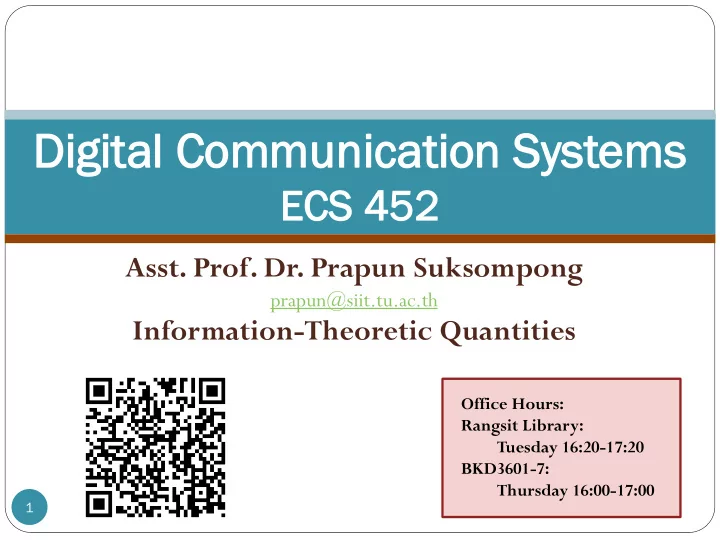

Di Digi gital tal Co Comm mmuni unication cation Sy Syst stem ems ECS 452 EC Asst. Prof. Dr. Prapun Suksompong prapun@siit.tu.ac.th Information-Theoretic Quantities Office Hours: Rangsit Library: Tuesday 16:20-17:20 BKD3601-7: Thursday 16:00-17:00 1
i Grad Gr adin ing Sys ystem em Coursework will be weighted as follows: Assignments 5% Quizzes and In-Class Exercises 10% Class Discussion/Participation 10% Midterm Examination 35% • 6 Aug 2013 TIME 13:30 - 16:30 Final Examination (comprehensive) 40% • 15 Oct 2013 TIME 13:30 - 16:30 2
Reference for this chapter Elements of Information Theory By Thomas M. Cover and Joy A. Thomas 2nd Edition (Wiley) Chapters 2, 7, and 8 1 st Edition available at SIIT library: Q360 C68 1991 3
Channel Model The model considered here is a simplified version of what we have seen earlier in the course. In the next chapter, we will present how this model can be derived from the digital modulator-demodulator over continuous-time AWGN noise one. The channel input is denoted by a random variable X . The pmf p X ( x ) is usually denoted by simply p ( x ) and usually expressed in the form of a row . vector 𝑞 or The support 𝑇 𝑌 is often denoted by . The channel output is denoted by a random variable Y . The pmf p Y ( y ) is usually denoted by simply q ( y ) and usually expressed in the form of a row vector 𝑟 . The support 𝑇 𝑍 is often denoted by . The channel corrupts X in such a way that when the input is 𝑌 = 𝑦 , the output 𝑍 is randomly selected from the conditional pmf 𝑞 𝑍|𝑌 𝑧|𝑦 . This conditional pmf 𝑞 𝑍|𝑌 𝑧|𝑦 is usually denoted by Q 𝑧|𝑦 and usually expressed in the form of a probability transition matrix Q . 𝑟 = 𝑞 Q Q y x Y X 4
“Information” Channel Capacity Consider a (discrete memoryless) channel whose is Q( y | x ). The “ information ” channel capacity of this channel is defined as max ; max , , C I X Y I p Q p x p X where the maximum is taken over all possible input pmf’s p X ( x ). Remarks: In the next chapter, we shall define an “ operational ” definition of channel capacity as the highest rate in bits per channel use at which information can be sent with arbitrarily low probability of error. Shannon’s theorem establishes that the information channel capacity is equal to the operational channel capacity. Thus, we may drop the word information in most discussions of channel capacity. 5
Binary Symmetric Channel (BSC) 0,4,0.6 H Y X H 0.6 0.4 0.6 0 0 q p ,1 p 0 0 0.4 0.6 0.4 X Y 0.4 ; 0,4,0.6 I X Y H q H 1 1 0.6 0.03 0.025 0.02 0.6 0.4 Q I(X;Y) 0.015 0.4 0.6 0.01 0.005 p p ,1 p 0 0 0 0 0.1 0.2 0.3 0.4 0.5 0.6 0.7 0.8 0.9 1 p 0 p Capacity of 0.029 bits is achieved by 0.5, 0.5 6
Binary Asymmetric Channel p Ex. p 0.9, 0.4 1- p 0 0 p 0.1 X Y 0.09 0.08 1 1 0.07 1- 0.06 I(X;Y) 0.05 0.04 1 p p 0.03 Q 0.02 1 0.01 0 0 0.1 0.2 0.3 0.4 0.5 0.6 0.7 0.8 0.9 1 p 0 p Capacity of 0.0918 bits is achieved by 0.5380, 0.4620 7
Iterative Calculation of C In general, there is no closed-form solution for capacity. The maximum can be found by standard nonlinear optimization techniques. A famous iterative algorithm, called the Blahut – Arimoto algorithm, was developed by Arimoto and Blahut. Start with a guess input pmf p 0 ( x ). For r > 0, construct p r ( x ) according to the following iterative prescription: 8
Berger plaque 9
Richard Blahut Former chair of the Electrical and Computer Engineering Department at the University of Illinois at Urbana-Champaign Best known for Blahut – Arimoto algorithm (Iterative Calculation of C) 10
Raymond Yeung BS, MEng and PhD degrees in electrical engineering from Cornell University in 1984, 1985, and 1988, respectively. 11
Recommend
More recommend